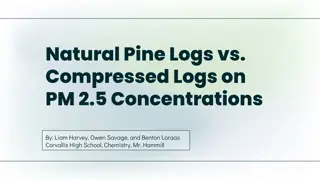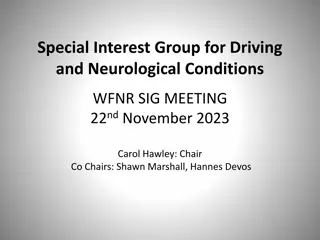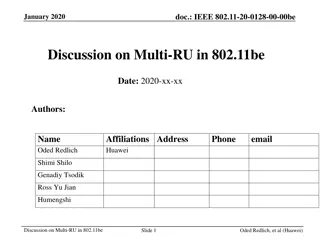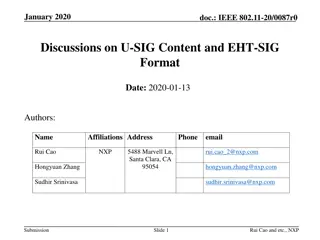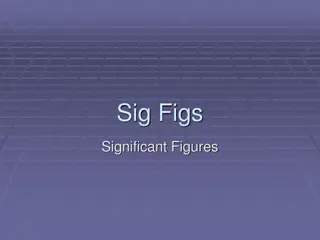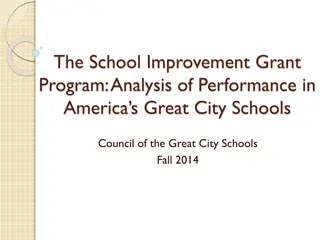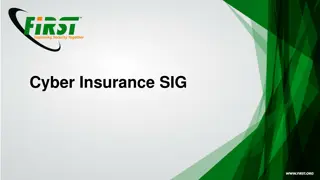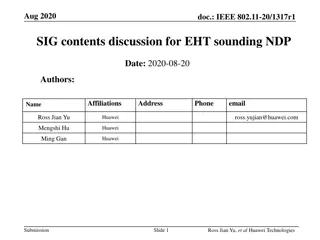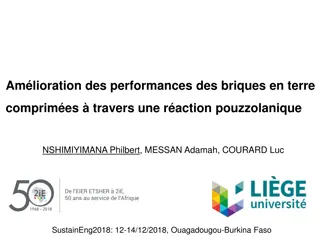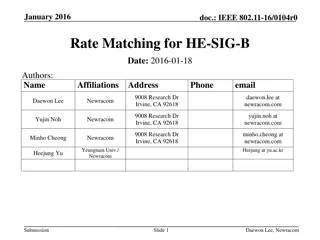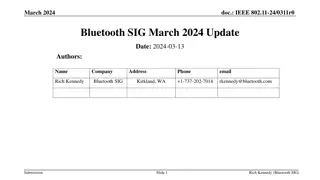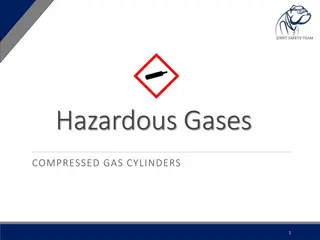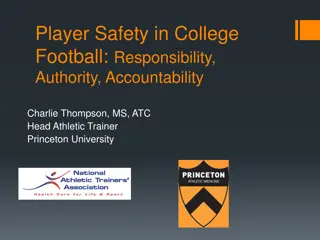
Issues with IEEE 802.11-16/0040r0 Compressed SIG-B Mode
In this document dated January 18, 2016, authors from Newracom and Yeungnam University discuss encoding structures and ambiguities in the IEEE 802.11-16/0040r0, particularly focusing on the HE.SIG-B encoding structure, compressed SIG-B mode, and challenges in blind determination of STA-specific fields at the receiver. They address the need for explicit signaling to simplify receiver implementation.
Download Presentation

Please find below an Image/Link to download the presentation.
The content on the website is provided AS IS for your information and personal use only. It may not be sold, licensed, or shared on other websites without obtaining consent from the author. If you encounter any issues during the download, it is possible that the publisher has removed the file from their server.
You are allowed to download the files provided on this website for personal or commercial use, subject to the condition that they are used lawfully. All files are the property of their respective owners.
The content on the website is provided AS IS for your information and personal use only. It may not be sold, licensed, or shared on other websites without obtaining consent from the author.
E N D
Presentation Transcript
January 2016 doc.: IEEE 802.11-16/0040r0 Issues with Compressed SIG-B Mode Date: 2016-01-18 Authors: Name Affiliations Address Newracom Phone email yujin.noh at newracom.com daewon.lee at newracom.com minho.cheong at newracom.com Heejung at yu.ac.kr Yujin Noh 9008 Research Dr Irvine, CA 92618 9008 Research Dr Irvine, CA 92618 9008 Research Dr Irvine, CA 92618 Daewon Lee Newracom Minho Cheong Newracom Heejung Yu Yeungnam Univ./ Newracom Submission Slide 1 Yujin Noh, Newracom
January 2016 doc.: IEEE 802.11-16/0040r0 Background SFD states the following [1]: The encoding structure of each BCC in HE-SIG-B was agreed: Two users are grouped together and jointly encoded in each BCC block in the user specific section of HE-SIG-B The common block has a CRC separate from the CRC of the user specific blocks The last user information is immediately followed by tail bits (regardless of whether the number of users is odd or even) and padding bits are only added after those tail bits Compressed SIG-B structure was agreed: A compression bit is carried in the HE-SIG-A MU format to differentiate full BW MU-MIMO from OFDMA MU PPDU. In case of full BW MU-MIMO, the following conditions hold: Only applicable for RU sizes 242, 484, 996, 2*996 The RU information in HE-SIG-B common is not signaled For bandwidths > 20 MHz, the user specific sub-fields are split equitably between the two HE-SIG-B Channels Submission Slide 2 Yujin Noh, Newracom
January 2016 doc.: IEEE 802.11-16/0040r0 HE SIG-B Encoding Structure In SIG-B, the RU information in the Common Field conveys information regarding number of STA-specific information. Number of STA-specific information conveyed in Common Field STA 3, 4 Channel 1 Common Field STA 1, 2 Pad SIG-B Common Field STA 5, 6 STA 7 Channel 2 Pad In the compressed SIG-B mode, the RU information in HE-SIG-B common is not signaled to reduce overhead. How does the receiver determine this? How does the receiver determine this? Channel 1 STA 3, 4 STA 1, 2 Pad STA 1, 2 Pad Compressed SIG-B OR STA 5, 6 STA 7 Channel 2 Pad STA 3, 4 Pad Submission Slide 3 Yujin Noh, Newracom
January 2016 doc.: IEEE 802.11-16/0040r0 Ambiguity in the STA-Specific Field Number of scheduled STAs is needed for Parsing Spatial configuration subfield Submission Slide 4 Yujin Noh, Newracom
January 2016 doc.: IEEE 802.11-16/0040r0 Multiple Hypothesis at the Receiver Blindly determining STA-specific fields Might be possible with additional receiver complexity. Assumes that CRC of STA-specific fields all pass. Detection and implementation challenges exist if CRC length is small such that false positive probability is quite high. Number of hypothesis depends of number of STAs in compressed SIG-B. Number of STAs that can be transmitted a function of SIG-B MCS and Number of OFDM SIG-B symbols. Some MCS and number of OFDM symbol combination does result in unique mapping. However, other combinations may require multiple hypothesis. We prefer not to blindly detect this. Explicit signaling allows simpler receiver implementation. Slide 5 Submission Yujin Noh, Newracom
January 2016 doc.: IEEE 802.11-16/0040r0 Strawpoll #1 Do you agree to include the following text to TGax SFD: In MU PPDU, the SIG-A shall indicate the number of STAs when compressed SIG-B mode is indicated (i.e. full bandwidth MU-MIMO indicated). Details TBD Y/N/A Submission Slide 6 Yujin Noh, Newracom
January 2016 doc.: IEEE 802.11-16/0040r0 References [1] 11-15-0132-13-00ax-spec-framework Submission Slide 7 Yujin Noh, Newracom
January 2016 doc.: IEEE 802.11-16/0040r0 Appendix: Multiple Hypothesis With 2 OFDM symbols in MCS 0 (BPSK ) 52 bits are available in SIG-B. Assuming each STA-specific field is approximately 21 bits, 2, 3, or 4 STAs can be multiplexed in 2 OFDM symbols. To reduce the hypothesis number, the test starts with SIG-B2 decoding . 52 bits The SIG-B channel 2 field has two possibilities of the information lengths; - Scenario 1) only one STA-specific subfield and CRC/Tail included - Scenario 2) two STA-specific subfields and CRC/Tail included SIG-B1 field Case 1 SIG-B2 field After checking both two scenarios, the format of SIG-B2 determined SIG-B1 field Case 2 SIG-B2 field In scenario 1, the same procedure as above is repeated in SIG-B channel 1 to find the number of users In scenario 2, SIG-B channel 1 must contain 2 users SIG-B1 field Case 3 SIG-B2 field Submission Slide 8 Yujin Noh, Newracom

